Short Travel Guide to Florence
Tucked in the heart of Tuscany, Florence will charm you with its views, architecture, and quaint cafés. The city is a living and breathing monument to the Renaissance, a period of great cultural change and the rebirth of humanistic ideals of antiquity during 14th - 16th centuries. Its well preserved historic centre will take you back in time, tracing the steps of the powerful Medici family and some of the major artists of the time, including Michelangelo, Donatello, Brunelleschi, and Da Vinci.
With one of the best art collections in the world, Florentine basilicas, museums, and villas make the city an unmissable destination for culture enthusiasts, luring them to return again and again. Lesser-known masterpieces, the city gardens will provide a breezy break in the midst of the Italian summer, while exploration of the local cuisine and world-famous red wine at historical cafés or family-run osterie will complete your trip. Whether you choose an evening walk along the Arno river, sunset from a medieval tower, or arts and crafts by local artisans, Florence will not leave you disappointed.
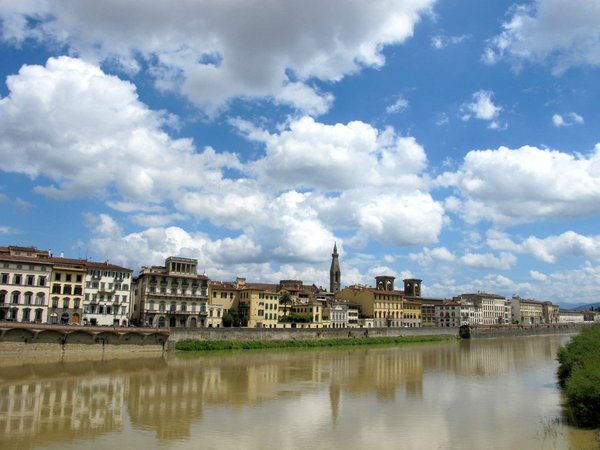
Along the Arno river / Photo by Anya Prosvetova
Fun Facts about Florence
-
Florence was established by Julius Caesar in 59 BC as a settlement for his veteran soldiers, and was called Fluentia due to its location between two rivers. Later, the name was changed to Florentia, which means ‘flowering’.
-
Florence has several emblems, which can be seen on buildings and decorations across the city. The main one is a red lily, which image derives from the Florentine iris, a white flower common in the area. The lily is frequently combined with another important symbol - the Marzocco. It is a representation of a seated lion, resting its paw on the red lily emblem. A symbol of the city’s independence, it derives its name from Marte (‘Mars’), and dates back to the early days of the city. Lions actually lived in Florence up until 1550. They were kept in cages behind Palazzo Vecchio, where now Via dei Leoni is. According to the late 13th-century legend, a lion once escaped from the cage and captured a child. He later returned it unharmed to its mother, and since then lions were seen as a sign of good luck.
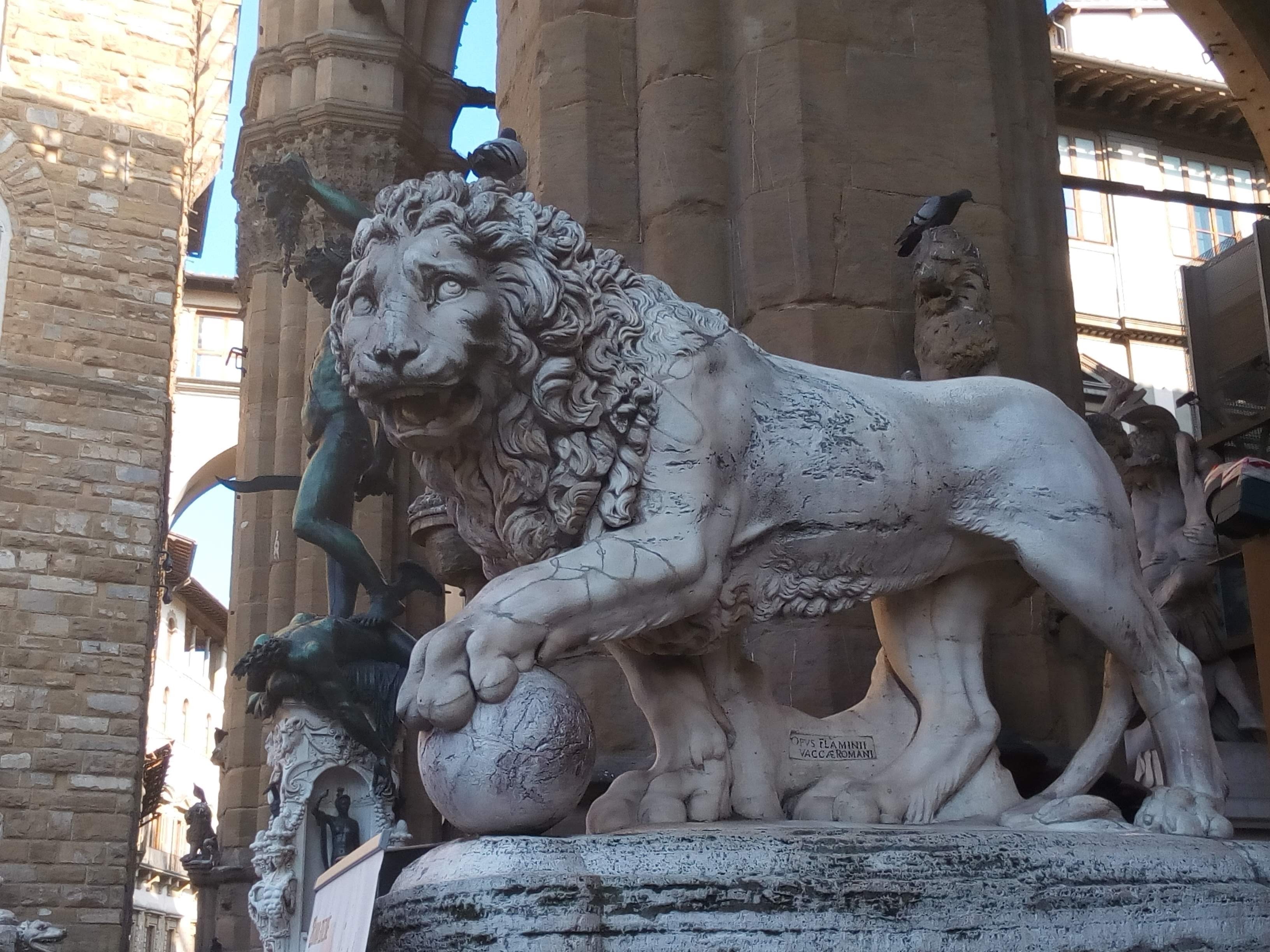
Lion of the Loggia dei Lanzi in Florence / Photo by Joe Planas on Unsplash
-
The so-called Standard Italian, the official language of Italy, has its roots in Florentine dialect. It was formalised in the 14th century by Dante Alighieri. In his writings, including The Divine Comedy, he mixed Southern Italian languages with his native Florentine.
-
Florence is frequently called an ‘open-air museum’ due to the amount of artistic and cultural heritage in the city. According to UNESCO, nearly a third of the world’s art treasures reside in Florence. Wander around the city’s historical centre to enjoy the Cathedral by Brunelleschi, the Bell Tower by Giotto, and other harmonious masterpieces of Renaissance architecture. Visit the Uffizi Gallery, the Bargello museum, or the Academy to appreciate the works by Leonardo da Vinci, Michelangelo, and Donatello.
-
While exploring the art treasures of Florence, be careful: the abundance of art and beauty can lead to a medical condition, known as ‘Florence syndrome’ or ‘Stendhal syndrome’ since 1982. It is named after French author Henri Stendhal, who stayed in Florence in 1817. After some time in the city, he was emotionally overwhelmed by its aesthetic beauty, feeling dizziness, palpitations, and even getting panic attacks.
-
Location on the banks of the Arno River was not always beneficial for Florence. In November 1966, the river rose for more than 5.2 metres after torrential rainfall, and killed more than 100 people. The flood also severely damaged or destroyed numerous works of art and rare books. Italian and international volunteers, who became known as ‘Mud Angels’, arrived to the city to help with the cleanup and restoration process. Decades later, some works of art and buildings still wait to be restored.
-
It may come as a surprise, but Florence was the first city in Europe with paved streets, laid out in 1339. Despite the road system in place, finding an address in Florence can be confusing. Still today the streets have double numbers, in red (for businesses) and in black (for residential buildings). For example, the address Via dei Neri, 30/32R (rosso or ‘red’ in Italian) signifies a business.
-
Today Florence is the capital of Tuscany, but shortly after the unification of Italy in 1861 it was made the capital of Italy. As an effort to modernise the city, Florence replaced Turin as the capital between 1865 - 1871. The old market on Piazza del Mercato and some of the medieval quarters were demolished to give the way to newer houses and formal street plan. Piazza della Republica as we see it today was widened, and a triumphal arch was added at its west end. Once the French army withdrew from Rome in 1870, it was possible to add Rome to the Italian Kingdom, and, subsequently, make it a new Italian capital.
Top Attractions in Florence
- Santa Maria del Fiore Cathedral (Duomo)
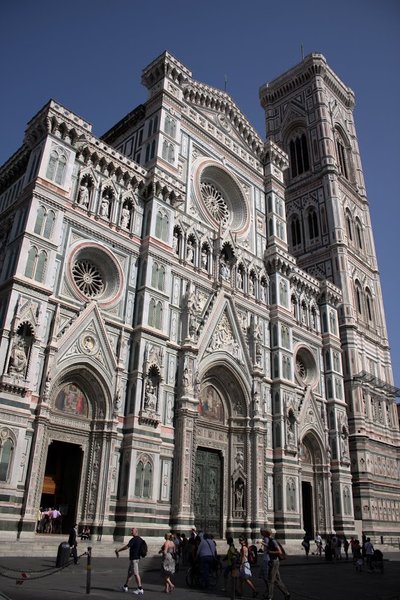
Santa Maria del Fiore, Florence / Photo by Anya Prosvetova
The main church of Florence, the cathedral was begun in 1296 in the Gothic style by Arnolfo di Cambio (1240 -1310), but was completed only 1436. The third largest church in the world, the Duomo is built over an Early Christian church, dedicated to St Reparata, the remains of which can be seen in the crypt. The Duomo’s festive facade of white, green, and pink marble was designed by various artists, including di Cambio and Giotto (1266 - 1337), but was completed only after the unification of Italy in the end of the 19th century.
The most famous feature of the cathedral and Florence itself, the cupola of the Duomo rises over the Renaissance city. Constructed by Filippo Brunelleschi (1377 - 1446) between 1418 and 1434, it is one of the first examples of the Renaissance architecture. The ambitious scale of the cathedral called for an octagonal dome higher and wider, than anything built before, without external buttresses to keep it from falling. Inspired by the Roman Pantheon’s single concrete shell, Brunelleschi used a system of two dome shells of brick to make the 45-meter dome as light as possible. He also supported the structure with eight visible ribs and 16 concealed ones, which are interlocked with each other by horizontal stone and iron chains, acting as barrel hoops. Today you can explore the structure of the cupola from the inside, while climbing its 463 stone steps between the shells of the dome. It might sound a little bit extreme, but you will be rewarded with a sweeping view of Florence.
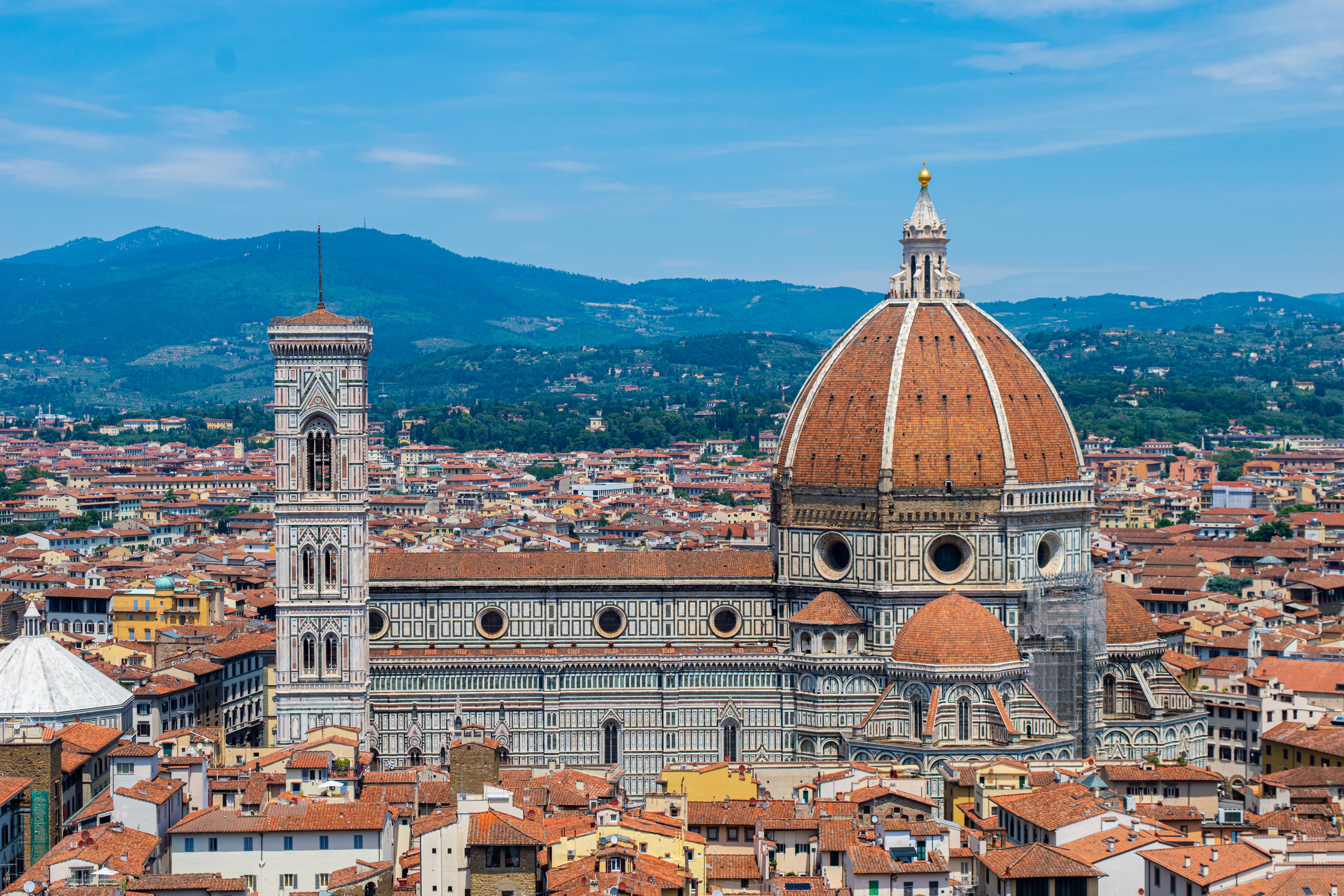
Brunelleschi's Dome of Santa Maria del Fiore / Photo by Joseph Quam on Unsplash
The interior of the cathedral with its plain decoration may seem less festive than the exterior. Many works of art have been removed throughout the centuries to the nearby Museum of Opera di Santa Maria del Fiore, leaving the striking mosaic floor, stained glass windows, and painted dome’s ceiling as major attractions. Executed by Giorgio Vasari (1511 - 1574) and his pupil Federico Zuccari (1540 - 1609), fresco decorations of the dome depict the scene of the Last Judgement. You can see the decoration closer from a special balcony on the way to the top of the dome.
Before leaving the church have a look at a unique clock on the back wall, designed by Paolo Uccello (1397 - 1475) in 1433. More than two meters in diameter, the dial shows 24 hours painted counterclockwise, corresponding to the run of the clock’s hands. The clock follows the so-called Italian Hour system, when the hours of the day are measured from sunrise to sunset, when the 24th hour is the sunset, not midnight.
Today the Duomo is a part of the Grande Museo del Duomo, including the cathedral, Baptistry of San Giovanni, Giotto’s Bell Tower, and the Museum of the Opera di Santa Maria del Fiore, all located around the Piazza del Duomo. Visit the Museum to see many original artworks from the cathedral and the Baptistry, including the impressive original gilded doors of the Baptistry by Lorenzo Ghiberti (1378 - 1455), and climb the Bell Tower for yet another breathtaking view.
The admission to the cathedral is free, but entry to other sites is ticketed. You can purchase a single ticket to visit for all monuments, including visit to the dome, bell tower, baptistery, crypt and the museum on the official website. Remember to check the opening times, and wear suitable clothing for your visit of the cathedral (no shorts, sandals or sleeveless tops are allowed).
- Galleria degli Uffizi
It is difficult to image a trip to Florence without a visit to one of the most astonishing art collections in the world. Located in Palazzo degli Uffizi (Piazzale degli Uffizi, 6) formerly occupied by government offices, the collection was assembled by the Medici family, and was bequeathed to the city in 1743. They requested that the collection will never leave Florence, so if you want to see Botticelli’s The Birth of Venus, Titian’s Venus of Urbino, or Michelangelo’s Doni Tondo, make sure to dedicate at least an afternoon for this museum. The collection of more than 3,000 works is displayed chronologically from Ancient Greece to 18th century Venetian paintings, focusing on the art of the Renaissance. Do not miss La Tribuna (Room 18), an exquisite octagonal-shaped treasure room, created between 1581 and 1586 to house a small collection of classical statues and paintings. The room has been recently restored to its original glorious state, with the crimson silk upholstery on the walls and 6,000 mother-of-pearl shells encrusting the ceiling.
The gallery is usually closed on Mondays with occasional closures on other days. Check the official website for more details, and to book the tickets online to skip the line.
- Piazza della Signoria and Palazzo Vecchio

Neptune Fountain on Piazza della Signoria / Photo by Anya Prosvetova
Visit to the Uffizi can be quite exhausting, so why not to treat yourself to a good coffee or ice cream at one of the bars on Piazza della Signoria? This lively square next to Palazzo degli Uffizi has been a centre of the local life since 13th century. The place of social upheavals and important Florentine events, including the famous Bonfire of the Vanities in 1497, this square is one of the best spots to immerse in the city’s everyday. Enjoy the view of Palazzo Vecchio, Florence’s city hall, or escape the sun in the shadow of Loggia dei Lanzi, an open gallery featuring Renaissance sculptures. Here Giambologna’s Rape of the Sabine Women (1583), Benvenuto Cellini’s bronze Perseus (1554), and Agnolo Gaddi’s Seven Virtues (1384–89) are looking out at Ammannati Neptune Fountain and a copy of Michelangelo’s David, placed in front of Palazzo Vecchio in 1910.
Today you can visit Palazzo Vecchio and trace its history through the Antiquity with the remains of the ancient Roman theatre in the underground, Medieval times, when the building was erected, and the Renaissance, the height of the Florentine Republic. Admire the palace’s Salone dei Cinquecento (Hall of the Five Hundred), decorated by Vasari during 1555 - 1572. This commission was a part of a renovation plan of Cosimo I de’Medici, who made the palace his residence and centre of the government in 1540. Other rooms of the palace are decorated by Michelangelo, Donatello, and Leonardo. Take some time to discover secret routes in the palace, leading to an elaborate private studio of Francesco I de’ Medici, Cosimo’s Tesoretto, and the ceiling trusses that support the ceiling of Salone dei Cinquecento. Private rooms were located on the second floor of the palace, where you can visit Apartments of the Elements, Apartments of Eleonora of Toledo, and the Hall of Maps with the Mappa Mundi, a two-metre-tall sphere, the largest rotating globe of its time. Finish your tour of the palace enjoying the view from the Balustrade on the top of the palace’s Torre d’Arnolfo.
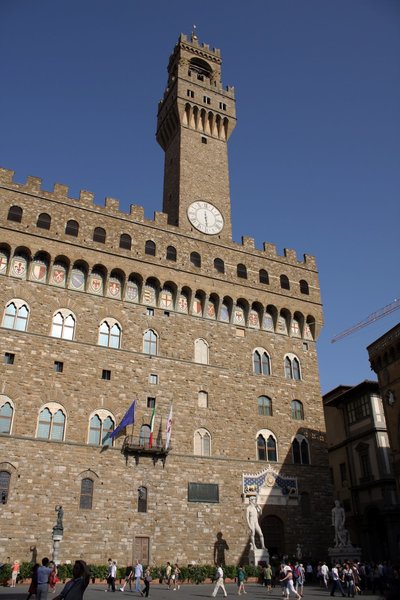
Palazzo Vecchio / Photo by Anya Prosvetova
Palazzo Vecchio and the tower are open everyday, with a shorter hours on Thursdays. Visit the website to confirm the opening times, and book your tickets (to the museum only, or combined, including the visit to the tower).
In 1565 Cosimo moved his residence across the river to Palazzo Pitti, and commissioned to Vasari a 1 km-long corridor, connecting the two palaces. Later, it was adorned by numerous artworks, including self-portraits of Andrea del Sarto, Rubens, and Rembrandt. Today this corridor is open only for private tours, which can be booked via Florence Town or Caf Tour & Travel.
- Basilica Santa Maria Novella
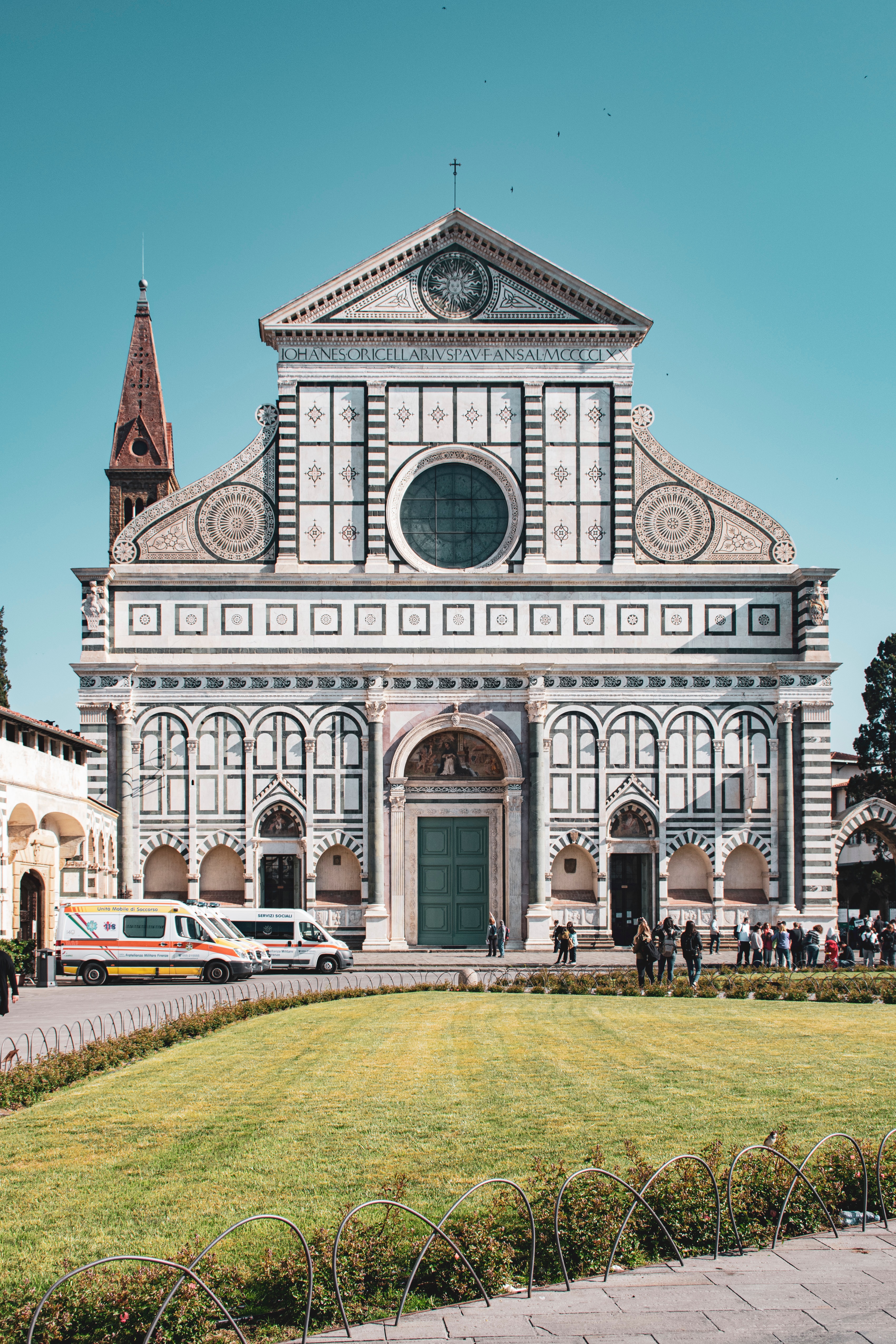
Basilica Santa Maria Novella / Photo by Eleonora Altomare on Unsplash
If you are arriving to Florence by train or bus, the basilica is the first thing you see when you get off. Built by Dominican friars between 1279 - 1357 as a part of the convent, it is the oldest Florentine church, and the only one with the original facade still in place. The lower part of the green-and-white marble facade was executed by Fra Iacopo Talenti da Nipozzano in the 14th century, while the upper part was completed only 100 years later in 1470 by Leon Battista Alberti (1404 - 1472).
The interior decoration echoes green and white marble of the facade. Many great artists created works for the church’s interior, and today some of them are on display at the Uffizi gallery, including Duccio di Buoninsegna’s Enthroned Madonna and Child (1258). However, some of the most striking examples are still housed in the basilica. Once inside the church, you are welcomed by Trinità (Trinity) by Masaccio (1401 - 1428). Created in 1424-25, this fresco depicts the crucifixion scene, masterfully employing newly discovered rules of perspective. An earlier wooden crucifix hanging in the central nave was painted by Giotto for the church in 1290.
The Strozzi Chapel to the right of the main altar is in turn decorated by Filippino Lippi (1459 - 1504) with the stories about of St John the Evangelist and St Philip the Apostle. One of the major visual discoveries awaits behind the main altar - the Cappella Maggiore with Domenico Ghirlandaio frescoes. Also called the Tornabuoni Chapel for its commissioner, the Tornabuoni family, it is dedicated to the Virgin Mary and St John the Baptist. Spend some time looking over these vibrant frescoes to spot the Tornabuoni family members depicted here, and learn more about the culture of the time. Don’t leave the church quickly, but spend some time wandering around the cloister and its chapels.
The church is open everyday with shorter times in winter. The tickets can be bought on site as well as online on the official website.
- Galleria dell’Accademia
Founded in 1784 as an addition to the Academy of Fine Arts of Florence, the gallery’s main attraction today is the original David by Michelangelo (1501-04). It was moved here from Piazza della Signoria for conservation reasons in 1873, being replaced by a copy. Carved from a single block of marble, it is a true masterpiece and emblem of Florentine power, liberty, and civic pride. The gallery also displays other works by Michelangelo, such as the unfinished San Matteo (St Matthew; 1504–08) and four Prigioni (Prisoners or Slaves; 1521–30). If you have more time for this museum, explore its less crowded galleries with collections of the Renaissance and Gothic art, musical instruments, and plaster casts by Lorenzo Bartolini (1777-1850), one of the professors of the Academy.
The Academia (Via Ricasoli, 58/60) is the second most visited museum in Florence, after the Uffizi, so it is recommended to reserve your ticket online in advance. Alternatively, you can take advantage of longer opening hours in summer, or enjoy quieter galleries in the afternoon.
- The Bargello National Museum
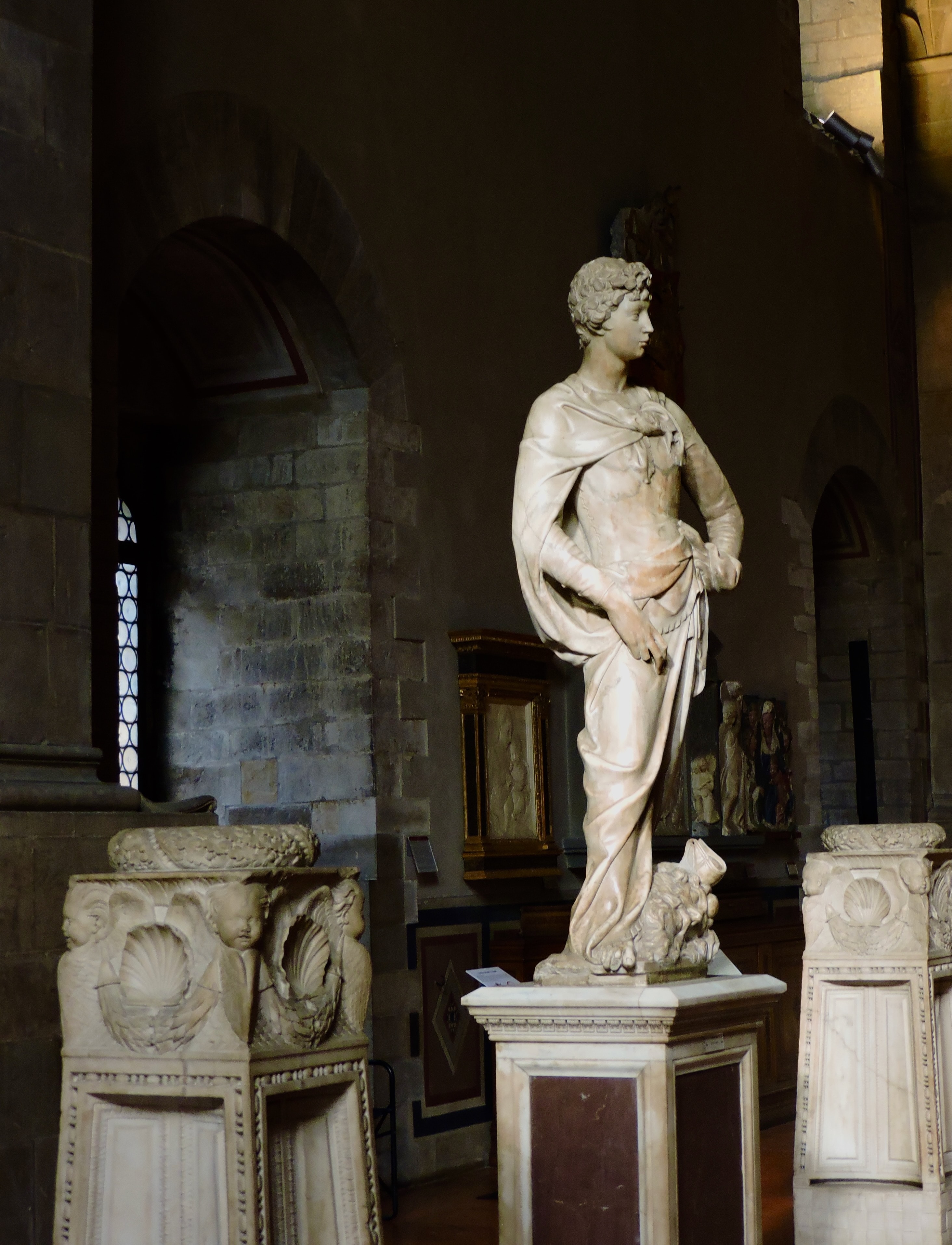
Bargello National Museum / Photo by Aelx on Unsplash
If sculpture is your favourite art form, make sure you visit the Bargello National Museum (via del Proconsolo, 4) while in Florence. Located in 1255 Gothic palazzo, this collection can be called ‘Uffizi for sculpture’. The museum was opened in 1859 and brings together some of the world famous sculptures, including St George (1416) and the bronze David (1440-50) by Donatello, a later version of David (1465) by Verrocchio, terracotta Madonna del Roseto (1450-55) by Luca della Robbia, and Bacchus (1497) by Michelangelo. Here you can also compare Sacrifice of Isaac (1401) bronze relief panels by Brunelleschi and Ghiberti, submitted for the competition to cast the Baptistery doors. The museum also holds a collection of goldwork, enamels, objects of ivory and tapestries.
The architecture of the museum is an attraction in itself with its inner courtyard and the grand staircase, leading to a second-storey loggia. The walls of the courtyard are covered with dozens of coat of arms of Florentine notable families.
The museum is closed on the 2nd and 4th Sunday of every month, and on the 1st, 3rd and 5th Monday of the month. You can book your tickets online, though there is rarely a line to this museum.
- Piazzale Michelangelo and San Miniato al Monte
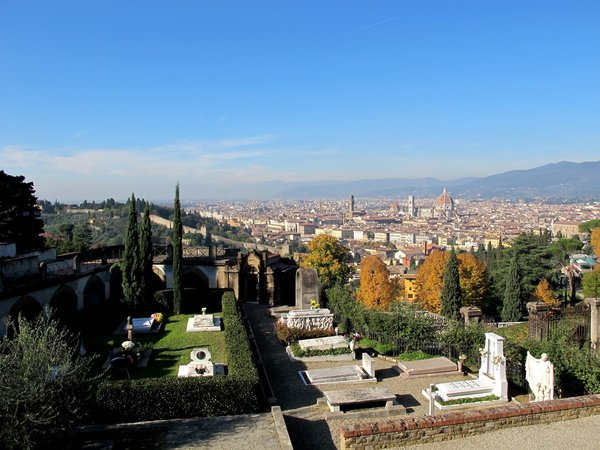
View from Piazzale Michelangelo / Photo by Anya Prosvetova
If you would like to see an iconic view over the city, take a bus or walk up the hill to Piazzale Michelangelo. A panoramic square was constructed in 1885 to present Florence and its hilly surroundings from the best possible side, and the view gets truly magical during sunset.
Continue further up the hill to find a charming [San Miniato al Monte](http://www.sanminiatoalmonte.it/){:target=”_blank”}, a Romanesque church hidden from the crowds. It is one of the oldest Florentine churches built between 11th and 13th century. The legend goes that San Miniato was a Christian martyr, who was decapitated in 250 AD. He picked up his head, walked across the river, and died only when he reached the spot where the church stays today. Behind the white and green marble facade you can discover a marble-inlaid interior with an elaborately carved presbytery, and tombs interspersed with inlaid marble symbols of the zodiac paving the floor. Don’t forget to visit the eerie crypt with frescoes by Taddeo Gaddi (1290 -1366).
- Palazzo Pitti
The core of this palace across the Arno river was designed by Brunelleschi in 1457 for banker Luca Pitti, and was later acquired by the Medici family. With time it grew into a massive complex you can visit today to enjoy art collections amassed by the Medici and Lorraine dukes. The museum group is led by the Uffizi’s rival, Palatine Gallery, the later stage of the Medici’s collecting featuring the works by Raphael, Titian, Rubens, and Andrea del Sarto. It is one of the few museums where the original display arrangement was kept with numerous works hang on top of each other. Overwhelming at times, it will bring you an authentic experience of a private collection in the 17th century. You can continue your journey back in time in the Royal Apartments (Appartamenti Reali), a series of fourteen splendid private rooms of the Medici and Lorraine families. It was also the home for the king of Italy from 1856 for the short period of Florence being the capital of the unified country.
Other museums in this complex include the Gallery of Modern Art with works by the 19th century Italian Impressionists called Florentine Macchiaioli school (from macchie - marks of colour on the canvas). Enjoy exquisite amber and ivory carvings, jewellery, and other works of art in the Museo degli Argenti, or trace the development of fashion from 16th to 20th century in the Costume Gallery, the only museum in Italy on the history of Italian fashion.
Palazzo Pitti is quieter than the Uffizi gallery, but they frequently organise loaned exhibitions, which can attract more visitors, than usual. If you wish to save time during your stay in Florence, book your tickets to the museum on the official website.
- Boboli Gardens
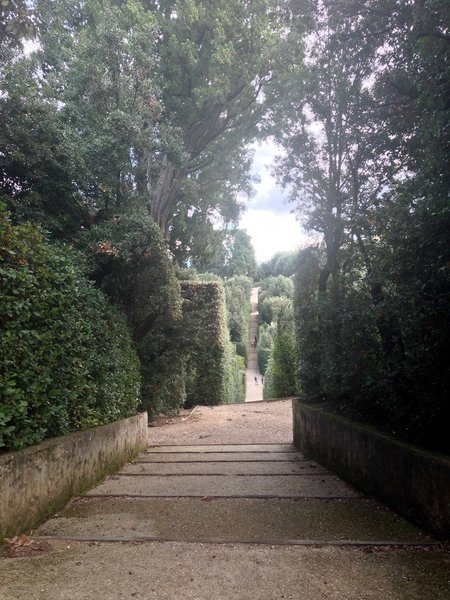
The Boboli Gardens / Photo by Anya Prosvetova
Despite the season of your trip to Florence, the Boboli Gardens will offer a welcome retreat from the city. Just behind the Palazzo Pitti, it offers some of the most impressive views over the Florentine countryside from the Giardino del Cavaliere. One of the earliest Renaissance parks, the Boboli Gardens were laid out between 1549 and 1656 featuring dozens of statues, fountains, rows of cypress, and even an amphitheatre modelled on Roman circuses. It was also the place of the first opera performance, Dafne, set in the gardens for the wedding reception of Ferdinando de’ Medici and Christine of Lorraine in 1589. Palazzina del Cavaliere on the upper slopes of the park holds a collection of the Porcelain Museum with pieces of European porcelain brought to Florence in the late 19th century to decorate the palace.
At the north end of the park you will find several artificial caverns resembling classical sacred grottos. The most famous and largest is the Grotta Grande designed by Giorgio Vasari, Bartolomeo Ammannati, and Bernardo Buontalenti during 1557 and 1593. It is decorated with stalactites, copies of Michelangelo’s Slaves (original in the Accademia Gallery), and equipped with waterworks. Stroll along the sloping Viottolone or ‘large avenue’, flanked by cypresses and statues, and don’t forget to greet the court dwarf Morgante riding a tortoise on your way out of the park.
The Boboli Gardens are open everyday with longer hours in summer (except for the first and last Mondays of each month), and tickets can be bought in the Palazzo Pitti. There is also a combined ticket option, which allows you to visit the museum complex and the gardens for a lower price.
- Cappelle Medicee (Medici Chapels)
A modestly looking building on Piazza di Madonna degli Aldobrandini, 6, the Medici Chapel will dazzle you with the interior decorated with marble work, granite, semi-precious stones, and captivating Michelangelo’s sculptures. Continuation of the Medici’s official church of San Lorenzo, the chapel was envisioned in 1520 as a mausoleum for the Medici family. Reflecting the harmonious and unassuming design of Brunelleschi’s Old Sacristy in San Lorenzo, Michelangelo created one of his early masterpieces for the New Sacristy space. Here you can encounter the sculptor’s mysterious creations: the statues of the Dukes Lorenzo and Giuliano over their tombs, allegorically reflecting the two sides of man: thought and action. The tombs are adorned with the lying sculptures of Night and Day, and Dawn and Dusk respectively. The third burial place holds the remains of Lorenzo the Magnificent and his brother Giuliano. It is topped by Michelangelo’s Madonna and Child, and figures of saints Cosmas and Damian, the protectors of the Medici family.
Another part of the Medici Chapel is the Cappella dei Principi (Chapel of the Princes), an absolute antipode to the quiet decoration of the New Sacristy. Its domed octagonal interior is covered with granite, polychrome semi-precious stones, and completed with bronze sculptures. Its ceiling was previously covered in lapis lazuli (a deep blue semi-precious stone), but today it is frescoed with scenes from the Old and New Testaments.
It is better to plan your visit in the morning, because the chapel is open until 1:50pm every day. Visit the official website for more details, and to book your ticket.
Things not to miss in Florence
- Admire Renaissance masterpieces of fresco painting
Among various artistic treasures, Florence is the home to some of the most astonishing frescoes. A technique closely associated with Italian Renaissance painting, fresco was popular in the Central and Southern Italy due to the dry climate. Visit 13th century Basilica di Santa Maria del Carmine (Piazza del Carmine 14) to admire the scenes of St Peter’s life in its Cappella Brancacci. Depicted by Masaccio between 1423-28, the cycle is considered a break from Gothic art towards the Renaissance. The Expulsion of Adam and Eve from Paradise and The Tribute Money on the left side of the chapel are some of the best known scenes.
Another frequently overlooked jewel is the Cappella dei Magi at Palazzo Medici-Riccardi (Via Cavour 3) with elegant and vibrant frescoes by Benozzo Gozzoli (1421 - 1497). Procession of the Magi to Bethlehem cycle (1459 - 63) depicts not only a New Testament story, but also the Medici family members as its participants: look closer to find Lorenzo the Magnificent and Cosimo the Elder in the crowd. The family lived in the palace until 1540, selling it to the Riccardi family a century later.
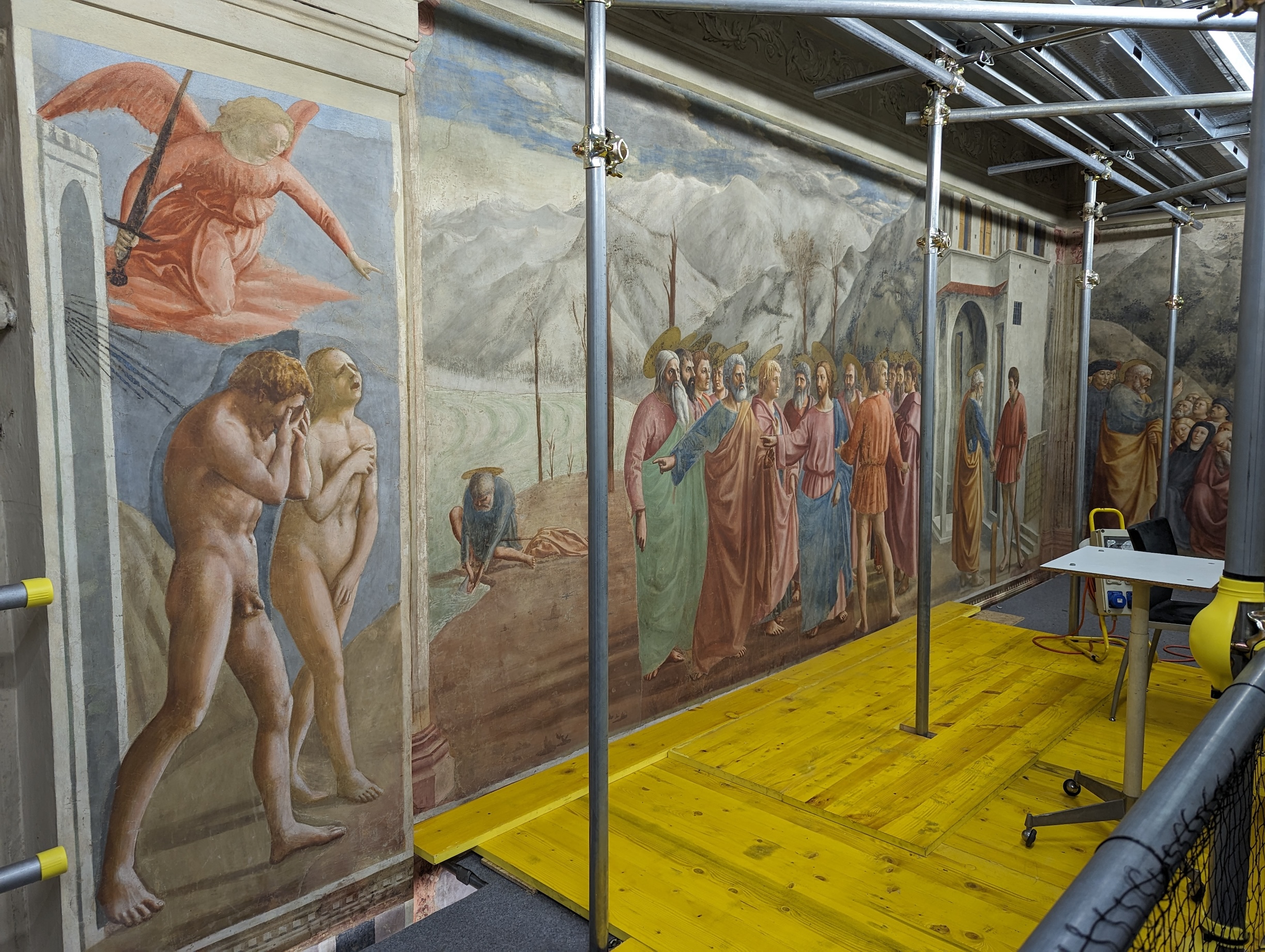
Frescoes in Capella Brancacci / Photo by Anya Prosvetova
Both chapels are less popular among tourists, however, have certain limitations for a number of visitors at a time. It is better to reserve your tickets in advance to avoid disappointment.
- Take a break from shopping at the Museo Salvatore Ferragamo
Florence is famous for its fashion as well as for its art and culture. The hometown for some of the most famous designers, including Salvatore Ferragamo, Gucci, and Roberto Cavalli, Florence continues attracting fashionistas from around the world, offering something more than a simple shopping. Have a break from fitting rooms, and tour the Salvatore Ferragamo Museum (Piazza Santa Trinita 5/R). It is located in 13th-century Palazzo Spini-Feroni, the headquarters of the Ferragamo house since 1938. The collection documents over 10,000 pairs of the luxury footwear, produced by the company since 1927 until today, displayed on a rotating basis, changing every two years.
- Find a green oasis in the gardens of Florence
Spring and summer may be the busiest time to visit Florence, but it is also the best time to explore the city’s gardens and escape the crowds there. The Rose (Viale Giuseppe Poggi, 2) and Iris (Piazzale Michelangiolo) gardens at their blooming height in May, when you can enjoy a lazy picnic surrounded by the flowers’ vivid colours and aromas. Both gardens are located on the top of the hill, offering a lovely panoramic view of the city. Another garden to visit is the Bardini Garden (Costa San Giorgio, 2). Located nearby the Boboli Gardens, this park was opened to the public only in 2010 after a long restoration process. The garden with its villa was acquired by the antiquarian Stefano Bardini (1836 - 1922) in the early 20th century, and its terraces provide a great location for a lunch with the view.
Florence also the city of one of the oldest botanical gardens in the world, maintained by the University of Florence. Giardino dei Semplici (Via Pier Antonio Micheli, 30) was established by Cosimo I de’ Medici in 1545 as a garden for medical flowers, and covers over 2 hectares.
- Relax with a cup of coffee in one of the charming Florentine cafés
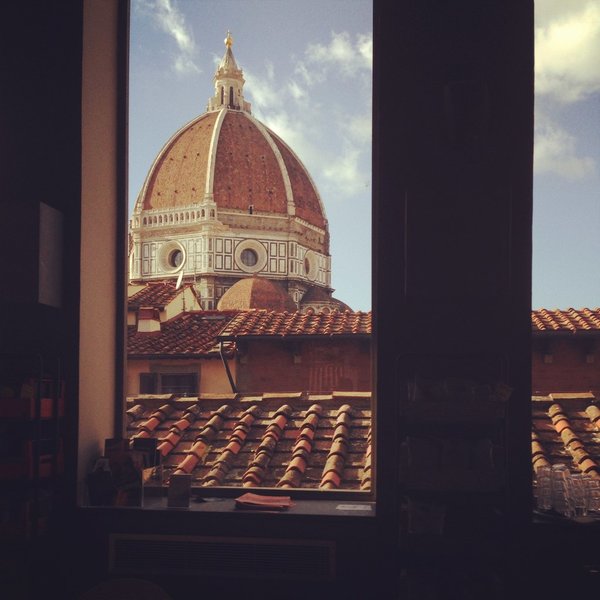
View form Caffè delle Oblate / Photo by Anya Prosvetova
It is difficult to imagine a day in Italy without coffee. Cafés have become an important institutions, where people meet, discuss ideas, and exchange news, and Florentine streets and squares offer many characteristic places for you to discover. If you in Sant’Ambrogio area, pop in Le Murate (Piazza delle Murate) located in a former Benedectine convent. This literary café is perfect if you want to spend some time with a book or participate in one of the events organised here. Caffè delle Oblate (via dell’Orioulo 24) is also located in the old convent, converted into a public library. But you do not need a library pass to enjoy a great close-up view of the Brunelleschi’s dome of the cathedral while sipping your cappuccino.
If you want something more sophisticated, have your next coffee break at Caffè Gilli (Piazza della Repubblica 39R). Opened in 1733, it was a meeting place for the 19th-century philosophers, writers, and artists. For something more contemporary head over to La Ménagére (Via dei Ginori, 8R), opened in the historical location of the first Florentine household store. Today its 1,500 square meters are turned into a bohemian restaurant, caffè, and design store, filled with vintage furniture and flowers.
- Stroll along the Arno river
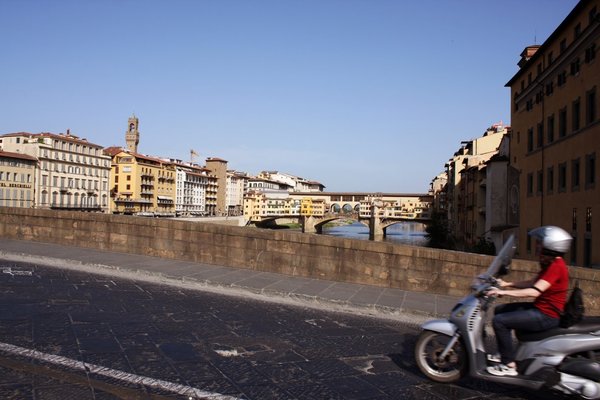
View towards Ponte Vecchio / Photo by Anya Prosvetova
When the museums are closing, but it is still too early for dinner, why not to take a stroll along the Arno river, and enjoy the perspective of Florentine bridges and crimson sunset sky? Start from the Ponte Vecchio, the most famous bridges in the city. It is built in the narrowest part of the river, and is the only remaining bridge with houses and shops on it. It is also the only bridge in the city, that was saved during the Second World War, while others were bombed in August 1944.
- Have a drink with a view
Do not leave Florence without having a drink in one of the bars with stunning views over the city. If you are catching a train, stop by luxurious The Western Excelsior Hotel (Piazza Ognissanti 3) to enjoy a cocktail in their rooftop garden overlooking the Arno river, or Grand Hotel Minerva (Piazza Santa Maria Novella 16) where you can enjoy a drink at their rooftop pool bar. To have an espresso or drinks on the top of a medieval tower, come to La Terazza Lounge Bar (Hotel Continentale, Vicolo dell’Oro, 6), where they also organise yoga classes with the view. To have a glass of prosecco with a view of the Duomo, go to the rooftop of La Rinascente shopping centre (Piazza della Repubblica, 1), offering a 360 degrees panoramic sight over the historic centre of Florence.
What to eat in Florence
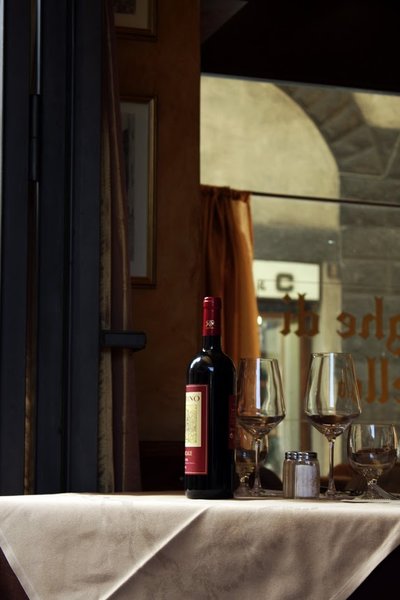
Dinner time in Florence / Photo by Anya Prosvetova
Florence is not only one of the major cultural centres, but also the capital of Tuscany, the region with a rich culinary tradition. Originating from a so-called cucina povera (‘peasant food’), Florentine dishes are usually prepared with simple, but fresh and local products. Together with flavourful Tuscan wines, olive oil is one of the most important ingredients in the region. Many of the olive trees in the areas are said to be about 600 years old, and produce olive oil with a taste more delicate, than the one from the South Italy.
If you are visiting the area in October or November, do not miss the season of new oil. You can find it in local stores or food markets. Visit San Lorenzo Central Market, Sant’Ambrogio in Piazza Ghiberti, or Fierucole in Piazza S.S. Annunziata to discover more seasonal specialities, and exchange new recipes with the locals.
Ribollita
If you are coming to Florence in late autumn or winter, you can enjoy this local thick soup-stew, perfect to keep you warm and satiated. The name ribollita means ‘reboiled’, and the soup has its roots in cucina povera, when the previous day’s vegetable soup was thickened with dry bread. It is not cooked like this today, but is still a go-to comfort food in the city. If you are in Florence in a hotter period, try panzanella, a summer version of ribollita, where a dry bread is used in a traditional Tuscan salad with tomatoes, olive oil, and spices.
Try it at: Trattoria La Casalinga, Via dei Michelozzi, 9R.
Bistecca Fiorentina
If you want to try just one typical Florentine dish, make it bistecca fiorentina or Florentine T-bone steak. Always priced by weight in a restaurant, this steak comes in pieces of 500-600 gramm, and should be shared between two people. The cooking method is straightforward: grill the meat over burning hot coals, season with salt, freshly grounded black pepper, and some olive oil. Cooked only for about 3-4 minutes on each side, the meat comes out almost rare, which highlights the tenderness of the beef from the Chianina cow. This breed comes from the Valdichiana in Tuscany, and is the only meet one should use for an orthodox bistecca fiorentina. Use the saltless Florentine bread to catch the juices from the meat, the only ‘sauce’ needed for this rich dish.
Try it at: Ristorante Latini, Via dei Palchetti, 6R, or Trattoria Mario, Via Rosina 2R (angolo Piazza del Mercato Centrale). If you want to try bistecca with a twist, give the blueberry or balsamic steak a go at Acqua al’Due, Via della Vigna Vecchia, 40R.
Schiacciata
A Tuscan version of focaccia, schiacciata is an easier version of this flat bread, sprinkled with olive oil and salt. Schiacciata means ‘pressed’ or ‘squashed’ in Italian, reflecting the cooking process: the dough is pressed down with your fingers when it is put in the baking tins. It is the only bread with flavour you will find in Tuscany. According to a legend, in the 12th century Florentines refused to pay salt tax to Pisa, producing saltless bread ever since. Schiacciata can be found in bakeries around the city as well as in many sandwich shops that offer it filled with ham, cheese, or other filings of your choice. There is also a sweet version, called schiacciata all’uva, made with wine grapes during the wine harvesting period.
Try it at: Focacceria Pugi, Piazza San Marco, 9 B, or Panificio Chicco di Grano at Mercato Sant’Ambrogio.
Pappardelle with cinghiale sauce
Florentine cuisine closely connected with the city’s hilly countryside, and not only through the olive oil. Cinghiale, or wild boar, is one of the inhabitants of the areas around Florence, and its meat is an important ingredient of one of the most popular pastas in the area, pappardelle with cinghiale sauce. The sauce of wild boar stewed in tomatoes goes perfectly with the sturdy wide ribbon pasta, pappardelle. Pair it with Brunello di Montalcino or Chianti Classico to perfect the taste of this hearty dish.
Try it at: Osteria dei Centopoveri, Via Palazzuolo 31.
Lampredotto
Exploration of Florence’s numerous museums can take up all day, but there is always time to taste a local speciality on the go. Stop by one of the food stalls or carts to taste an ultimate example of cucina povera - lampredotto sandwiches. They are made of cow tribe and served in a crusty bun, dipped in cooking broth and sprinkled with salt and pepper. It is usually served with a green sauce made of parsley, garlic, and anchovies.
Try it at: L’antico Trippaio, Piazza de’ Cimatori, Da Nerbone at Mercato Centrale, or Da’ Vinattieri, Via Santa Margherita 4R.
Cantucci
Whether you would like to add a sweet touch to your morning coffee or conclude a dinner with something special, try cantucci, a traditional Tuscan sweet, popular in Florence. Translated as ‘little corners’, these tiny double-baked biscuits are made with flour, eggs, sugar and almonds. Dunk them in coffee or Tuscan Vin Santo, a sweet liqueur wine made from grape must.
Try it at: Cantucci are widely available in bakeries around the city, but there are also places specialising in this dessert, such as Il Cantuccio di San Lorenzo, Via Sant’Antonino 23R. Buy a bag for yourself or as a present, and do not miss demonstrations on how to make cantucci, which take place here every morning at 9am.
Gelato or ice cream
Traditional Italian dessert, ice cream or gelato dates back to the era of the Medici, who organised a competition for the best cook of Tuscany. Chef Ruggieri, one of the participants, created an iced dessert of a cold custard with cream, zabaione, and fruit, which won the court over.
Whether you are coming to Florence for a day or spending a week here, exploring the city’s art and cuisine, it is impossible to skip a scoop of gelato on a square. Conveniently located close to the main tourist attractions, the numerous ice cream shops or gelaterie will cater the most demanding taste. Notice the sign artigianale or ‘artisan’, confirming that gelato here is produced from fresh natural ingredients, with no artificial colouring or preservatives added.
Try it at: Gelateria La Carraia, Piazza Sauro Nazario, 25R, for a creamy and soft ice cream. Visit Edoardo, Piazza del Duomo 45R, for an organic ice cream with unique flavours, including chianti. Perchè No (‘Why not’ in Italian) gelateria carries the Italian ice cream philosophy in its name. Located on Via dei Tavolini, 19, it is one of the oldest ice cream shops, founded in 1939. Treat yourself with a daily special: rose flavour on Monday or Apple pie on Friday.
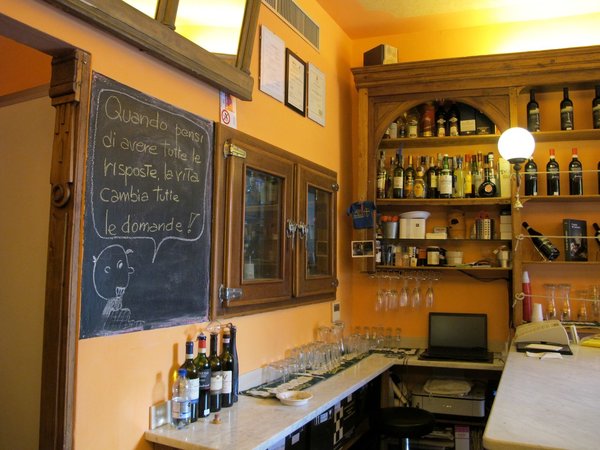
A traditional bar in Florence / Photo by Anya Prosvetova
Itineraries in Florence
Florence is a relatively small city, but you can spend weeks exploring its historical and cultural heritage. To understand its historical development, follow the steps of the Medici family. They became wealthy and powerful through the success in commerce and banking in the 13th century. Under the Medici rule during the 15th century, Florence became the cradle of the Renaissance and centre of culture, supported by the extensive patronage of the family. Explore the historic city centre of Florence and visit the major palaces, churches, and squares, connected with the Medici dynasty.
Relative stability and prosperity in the period after the Middle Ages led to the Renaissance, a period of increased interest in philosophy, literature, and, above all, art. The Medici family were famous for their support of Florentine artists, and the works commissioned during the late 14th - 15th centuries are seen today as masterpieces of the world art. Michelangelo Buonarroti (1475 - 1564) was born in a small town in Tuscany, but considered himself a true Florentine. The city’s museums and churches proudly displays some of the artist’s most striking works, including David at the Academia Gallery, sculptures in the Medici Chapel at San Lorenzo, and Tondo Doni (1504-1506) at the Uffizi Gallery.
When visiting Florence it is difficult to miss the trail of its another famous citizen, Dante Alighieri (1265 - 1321), a major Italian poet, author of The Divine Comedy. Along the way you will discover the buildings, related to Dante’s life, and the works of art that celebrate his legacy.
Home to one of the most impressive and important examples of architecture, Duomo by Filippo Brunelleschi (1377 - 1446), Florence is a place to be for any architecture enthusiast. From the Middle Ages, through Renaissance, and up to Italy’s Independence in the 19th century - the streets of Florence can surprise you with some fine examples of architectural ingenuity and composition.
Getting around and about in Florence
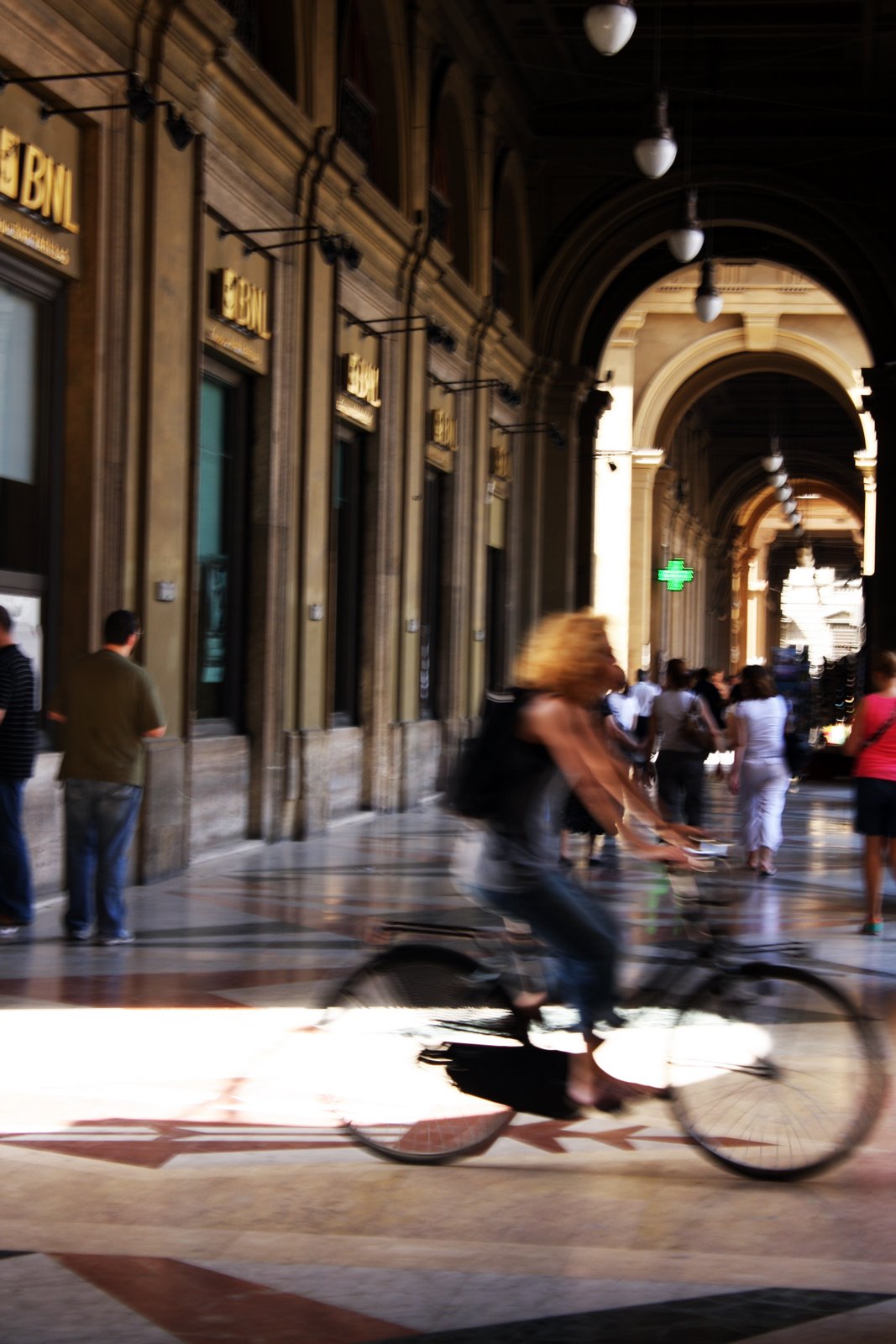
A typical Florentine scene / Photo by Anya Prosvetova
Florence is the city better explored on foot. You will spend not more than 10 minutes to stroll between its two major sites, Piazza del Duomo and the Uffizi museum. A walk from the most northerly major sights, San Marco and the Academia, to the most southerly, the Pitti Palace across the river, will take not more than 30 - 40 minutes. Remember about cobbled streets, and bring a pair of your most comfortable shoes with you.
If you prefer public transport, get to know Florence’s bus system, called ATAF. There is also a tram line, T1, which runs from Scandicci to Santa Maria Novella train station. A ticket costs 1.2 euro each, and allows you to travel for 90 minutes once validated. There are some special passes available too, valid for 24 hours, 3 or 7 days. Every bus stop in Florence has a sign indicating the bus routes stopping there and a unique code of the bus stop. Text this code to a phone number indicated on the stop sign to find out when the next bus will arrive.
You can buy bus tickets at tabacchi (tobacco shops), some bars, or newspaper stands: anywhere with ‘ATAF’ sticker on their window. Remember, that a bus ticket should be validated on board to avoid a fine. If you were not successful in finding a nearest vendor, you can still buy the ticket on the bus, which will cost you 2 euro. Alternatively, use your prepaid Italian mobile phone to text ‘ATAF’ to 488-0105 to get a validated ticket directly to your phone (costs 1.5 euro).
Historical city centre still keeps its Renaissance layout with charming narrow lanes and side streets, which limits the traffic. Thus, busses usually run along major streets only, with the exception for little electric busses C1, C2, C3, and D. Visit the official website to learn about any changes in bus routes, and to plan your journey around the city.
If you would like to see the city like a local, rent a bicycle or scooter. The city has a rather flat layout and restricted car traffic, which makes the exploration on a bike ever so pleasant. Take advantage of ‘Mille e una bici’ (‘Thousand and one bikes’), a special programme organised by the Florence City Council. With several hiring points around the city centre, it provides a convenient and affordable way to move around.
There are also other places offering rental services across the city, including Alinari on Via San Zanobi 38R, which rents bikes and scooters, or Florence by Bike, Via San Zanobi 54R. Do not forget to lock your bikes or scooters when leaving them on a street: bike theft is quite common.
Arriving to Florence
If a plane is the most convenient option for you, there are two major airports you can chose between ‘Amerigo Vespucci’ (FLR) and ‘Galileo Galilei’ (PSA). While ‘Amerigo Vespucci’ airport is located only 5 km from the city centre and welcomes the majority of international flights, ‘Galileo Galilei’ is located in Pisa, a town about 70km away from Florence, and usually serves the low cost European flights.
A dedicated ‘Vola in Bus’ service runs between the ‘Amerigo Vespucci’ airport and Santa Maria Novella, Florence’s central railway station. It departs from the airport every 30 minutes between 5:30am to 8:30pm, and every hour afterwards until 11:45pm, with the last bus departing at 1am. A 6 euro one-way ticket can be purchased on the bus, while a round trip ticket should be purchased at a bus station, newsstands, or bars with ‘ATAF’ sign displayed.
If you are arriving to Pisa, you can take a bus or train to Pisa city centre, followed by a train to Florence, or take a bus, such as Terravision, which will take you directly to Florence in 70 minutes.
Florence is at the centre of rail junctions in Italy and is easily reachable by train. Check Trenitalia website for the schedule and to book your tickets online. The main railway and bus station, Santa Maria Novella is located close to the historical centre. Another large railway station is Campo di Marte, which may be convenient for you, if you are staying just outside the historical centre, in the North East part of Florence.
Where to stay in Florence
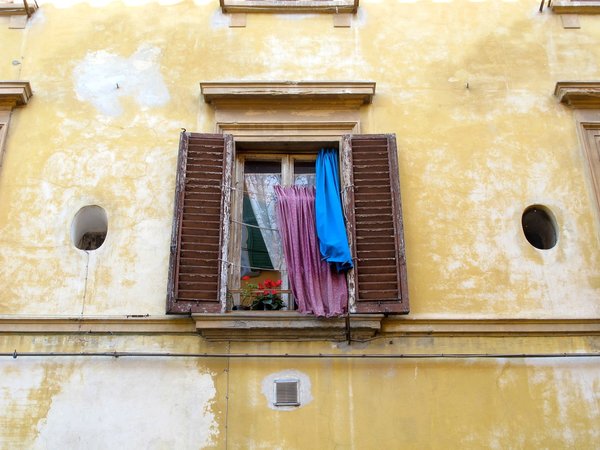
Photo by Anya Prosvetova
Luxury accommodation
Price / Quality ratio
Budget options & Family options
Unusual accommodation
Accommodation in the countryside
Souvenirs from Florence
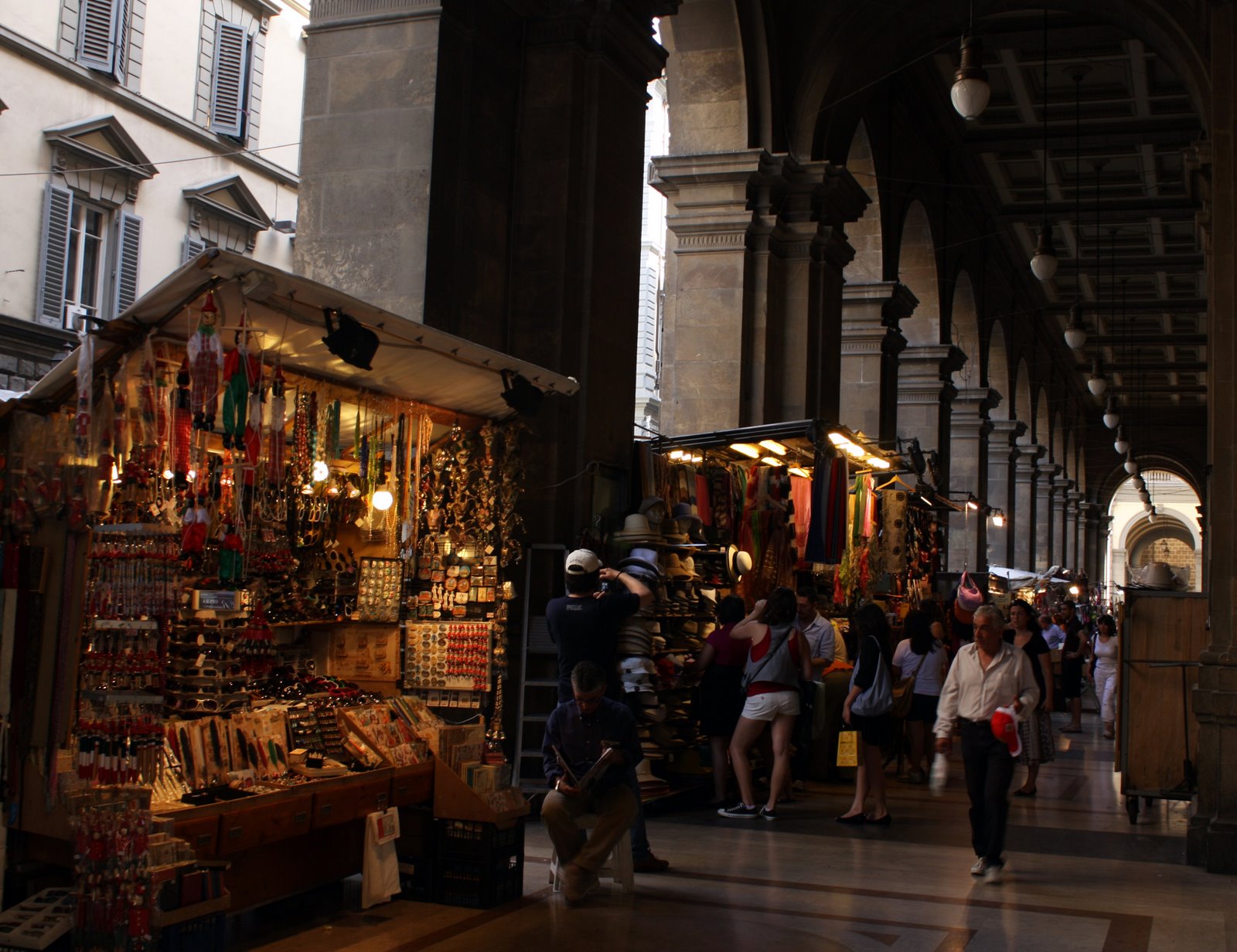
Street market in Florence / Photo by Anya Prosvetova
Bringing presents from travels can be a tricky thing, especially when you travel to cities like Florence. The city is full of artisanal little shops and markets, where you can choose just the right gift for your family and friends:
-
Leather goods are one of the traditional industries in Florence. Shoes, bags, belts, and gloves can be found on Via dei Calzaiuoli, or in the Oltrarno district, on the other side of the Arno river. Stop by Cellerini, Via del Sole 9, for a quality handbag, or pay a visit to Madova, Via Guicciardini 1R, to choose among more than 3,000 models of leather gloves.
-
Another traditional industry of the region is beauty products and fragrances. The history of many Florentine perfume and pharmaceutical workshops goes back to medieval religious orders and the heyday of the Medicis. Officina Profumo-Farmaceutica di Santa Maria Novella (Via della Scala 16) may be the most famous and one of the oldest in the city, founded in 1221. La Bottega dell’Olio in Piazza del Limbo 2R is a boutique specialising in olive-based products, including oils, soaps, and skincare products. For a truly unique experience, do not miss Aquaflor perfumery (Via Borgo Santa Croce, 6), offering not only organic soaps and body care products, but also over 1,500 essences from all over the world.
-
If you are looking for a present for someone, who appreciates the tradition of beautiful stationery, the city has plenty to offer. Follow the steps of Stendhal, Byron, and Dickens, and choose among leather notebooks, ink pens, paper produced with the Florentine marbling technique, or a personalised wax and seal set in some of the best city’s stationery shops: Papiro, Piazza Duomo, 2; Abacus, Via dei Ginori, 28R, or Giulio Giannini e Figlio, Piazza dei Pitti 37R. Or become a client of Pineider (Piazza della Signoria, 13-14R), where Napoleon ordered his calling cards.
-
Food is always a good souvenir when travelling in Italy. Stop by Procacci store on Via dè Tornabuoni, 64R to choose among their truffle products: honey, pastes, salts, and sliced or whole truffles. If you are looking for a nice cheese, vinegars, jams, chocolate, or sauces, visit Pegna Drogheria, Via dello Studio, 8. If you are travelling in late Autumn, look out for olio nuovo, new season’s extra virgin olive oil, which is available from many shops, markets, and street stalls. The heart of Tuscany, Florence is a great place to get a good bottle (or a case) of Chianti or Montepulciano. Many wine shops across the city offer a worldwide shipping, so you do not need to worry about your luggage.
-
Florence is a paradise for fashionistas with streets with designer stores offering shoes, clothes, and accessories. If you are looking for something special, why not to check boutiques selling vintage pieces, such as Street Doing on Via dei Servi 88R, Il Cancello on Via dei Fossi 13R, or Boutique Nadine on Via de’ Benci 32R.
-
Florence is the birthplace of Pinocchio, and wooden toys are one of the best gifts for children here. Pop in Bartolucci on Via Condotta 12R to browse handmade wooden toys and accessories.
-
If your friend is a jewellery fan, Florence is one of the best places to find them the perfect gift. There are plenty of shops on Ponte Vecchio, but to avoid high prices and tourist crowds, wander the streets of Florence to discover local craftsmen. Visit Alessandro Dari on Via di S. Niccolò, 115R for unique pieces, Penko workshop onVia Zannetti, 14/16R, who recreates jewellery from the Renaissance paintings, or Officina Nora on Via dei Preti, 4R for something more contemporary.
Tips for travellers to Florence
One of the best advices one can get before going to Florence: you can’t have it all. The city is full of amazing museums, palaces, and gardens, but it is impossible to visit all of them during a short visit. Remember to enjoy your holiday, and allow some time for unexpected situations or new directions Florentine streets could take you. Relax in one of the charming cafés, and give your feet some rest - there is always something breathtaking to see just around the corner.
It is a good idea to plan your museum visits ahead because of their tricky opening hours, which frequently change. The Uffizi and Accademia are closed on Mondays, while the Bargello closes at 1:50pm and is closed on alternating Sundays and Mondays. Museo di San Marco also closes at 1:50pm on weekdays, but stays open late on weekends.
As for the weather, Tuscan region has warm, mild climate throughout the year, while weather in Florence can slightly vary due to its location in the valley. July and August are the hottest months, and humidity makes it even more difficult to enjoy the city during this period. As in other Italian regions, many restaurants and public places in Florence are closed after August 15 for two or three weeks, so it is better to check the opening times in advance if you are planning to travel during these days.
Enjoying Florence on a budget
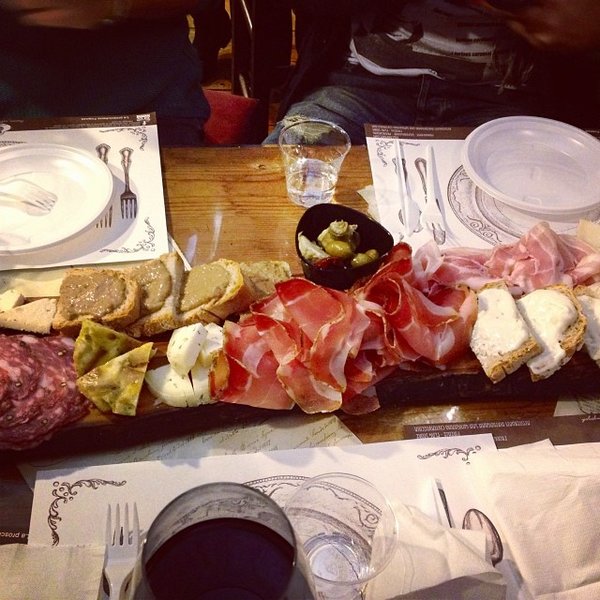
Tasty boards at La Prosciutteria / Photo by Anya Prosvetova
With its glamorous fashion boutiques and jewellery shops, Florence can come across as a city for the affluent. However, there is always something for everyone, whether you want to see art, enjoy the local cuisine, or refresh your wardrobe:
-
Planning to visit all major museums in Florence? Invest in the Firenze Card to get free and priority access to 72 museums and galleries, including the Uffizi. Valid for 72 hours, the card also includes unlimited bus travel around the city for this period. Ask for a special bus ticket when buying the card, and remember to validate it on your first bus ride. Another way to save on your museum visits is a one-for-all ticket for the Santa Maria Del Fiore. It includes the visit to the Cathedral itself, its Dome, the Bell Tower, Baptistery, crypt, and the museum.
-
Similar to other Italian cities, state museums in Florence do not charge admission on the first Sunday of the month. While it is a good idea to visit some smaller museums on that day, it is better to avoid the Accademia and Uffizi to escape the crowds.
-
With osterie, markets, and food stalls, Florence offers a range of options for visitors on a tight budget. For a quick bite on the go choose among one of the most popular panini places, such as I Fratellini (Via dei Cimatori, 38R), INO (Via dei Georgofili, 3R/7R), or All’Antico Vinaio (Via dei Neri, 74R). If you want to have a good meal without spending too much, visit La Prosciutteria (Via dei Neri 54R) for a mouthwatering selection of bread, prosciutto, and cheeses, or Osteria I Buongustai (Via dei Cerchi 15R) to try typical Tuscan food at modest prices.
-
For Florentines, drinks before dinner are as important as the dinner itself. Enjoy the local tradition of aperitivo, when bars offer unlimited finger food and nibbles with a drink for about 10 euro per person. It usually runs between 7 to 9pm, and was introduced to ‘open’ the stomach for dinner. However, many bars offer a good selection of food, making the aperitivo turn into a proper dinner. Spend an evening enjoying some live music at L’Ortone (Piazza Ghiberti, 87R), start your aperitivo at 5pm at Zoe Bar (Via dei Renai, 15), or join the locals at one of the many lively bars in Piazza Santo Spirito.
-
Save an extra euro or two on a table service when drinking your cappuccino or espresso at the bar instead of sitting at a table.
Day trips from Florence
Florence is the capital of Tuscan region, which hilly landscapes are full of charismatic little towns and villages. Whether you are travelling by bus, train, or car, there is always a new destination close to Florence.
Fiesole
The closest to Florence on our list, Fiesole village is just an hour walk from the city. Alternatively you can take a bus from Santa Maria Novella, and in just 30 minutes you will find yourself in the heart of Fiesole, Piazza Mino. Buy some food and wine at the square market, and head to the Monastery of San Francesco (Via San Francesco, 13). Here you can visit the convent’s chapels and the museum, and have lunch at the convent’s terrace with spectacular views over Florence.
Other places not to miss in Fiesole are the Bandini Museum with the collection of works by the Florentine painters of the Renaissance, and Etruscan-Roman Archeological area of the Civic Archeology Museum (Via Portigiani, 1). Here you will find the remains of Roman baths and the theatre, dating back to the 2nd century BC, as well as numerous artefacts from the Roman and Etruscan periods. In the 14th century Fiesole became popular among affluent Florentines, who enjoyed a break from the city at their villas with secluded gardens. Book your visit to the Villa Medici to enjoy the work of Leon Battista Alberti (1404 - 1472), one of the major Italian architects and philosophers, or Villa Peyron (Via di Vincigliata, 2) to enjoy its terraced gardens, lakes, and garden statues.
Prato
Prato is located only 20 kilometres to the west of Florence, and is the second largest Tuscan city, an important textile centre. After a 30-minutes train journey you will find yourself at the Prato Centrale railway station, a notable example of Italian Modernist architecture. Continue your way to Piazza del Duomo with its striking Romanesque Gothic Cathedral of Santo Stefano featuring Andrea della Robbia’s sculptured relief doorway and Donatello’s pulpit. Step inside to marvel at fine Early Renaissance frescoes by Paolo Uccello (1397 - 1475) and Filippo Lippi (1406 - 1469). Among other notable churches you can visit San Domenico church on Via Convenevole with the Museum of Mural Painting inside its cloister.
Another example of Medieval frescoed residence is Palazzo Datini (Via Ser Lapo Mazzei, 43) that belonged to Francesco Datini, one of the important fabric merchants in the city. Those who are interested in something more contemporary, should stop by Piazza San Marco for Henry Moore’s Square Form with Cut, donated by the sculptor to the city in 1974, or visit Centro per l’arte Contemporanea Luigi Pecci (Viale della Repubblica, 277), located just outside of the city walls.
Siena
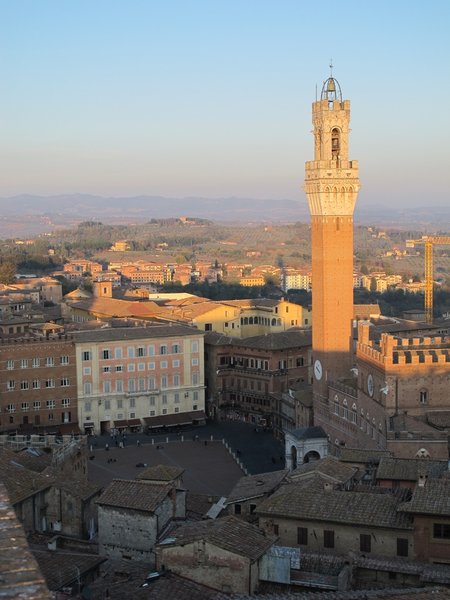
View over Piazza del Campo, Siena / Photo by Anya Prosvetova
One of the most visited destinations in Tuscany, Siena has been able to preserve its medieval charm due to its isolated location. The town is situated on the hilltop, and bus is the most convenient way to get there from Florence. Start your exploration of this UNESCO site from Piazza del Campo, one of the biggest medieval squares in the world. Its unique shell-like shape is the place of the famous Palio horse race, which has been taking place every 2 July and 16 August since 1300. Take 400 steps up the square’s Torre del Mangia to enjoy a beautiful views over the town and the Tuscan countryside.
Continue to Piazza del Duomo to see one of the most striking examples of Gothic architecture, the Cathedral of Siena, a home for works by Michelangelo in the Piccolomini Chapel. Do not miss other major Siena’s museums: Santa Maria della Scala to learn more about the town’s history, and Palazzo Pubblico with The Allegory of Good and Bad Government (1338 - 39), an extensive fresco cycle by Ambrogio Lorenzetti (1285 - 1348).
Pisa
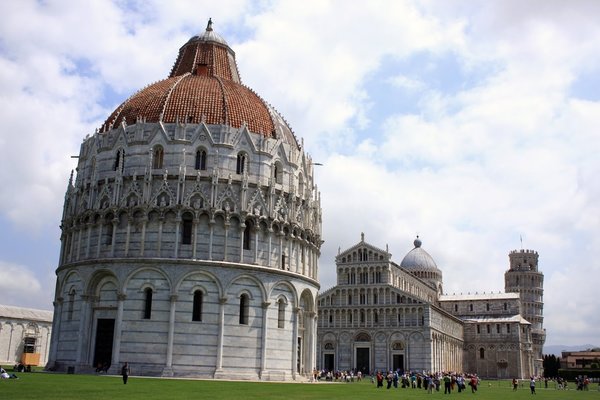
Piazza dei Miracoli, Pisa / Photo by Anya Prosvetova
Pisa and its Leaning Tower are just an hour train ride away from Florence. A short walk from the station will bring you to Piazza dei Miracoli, the main attraction of the city. Here you will find not only the famous tower, but also the Baptistery and the Cathedral of Pisa. But do not rush - turn to Piazza Sant’Antonio on your way from the train station to find a large vibrant mural Tuttomondo (1989) by Keith Haring (1958-1990), an American graffiti artist. If you want to explore the artistic traditions of Pisa, pay a visit to the National Museum of San Matteo (Lungarno Mediceo, Piazza San Matteo 1) to admire ceramics, sculptures, and paintings by local artists.
Alternatively, you can visit the National Museum of Palazzo Reale (Lungarno Antonio Pacinotti, 46), a gallery showcasing artworks from some of the most important European families. Spend your evening strolling along the Arno river, passing a local market at Logge dei Banchi (Via di Banchi, 2) and charming Chiesa della Spina on Lungarno Gambacorti. Finish your day out with a drink in Piazza Garibaldi, a centre of Pisa’s nightlife.
Lucca
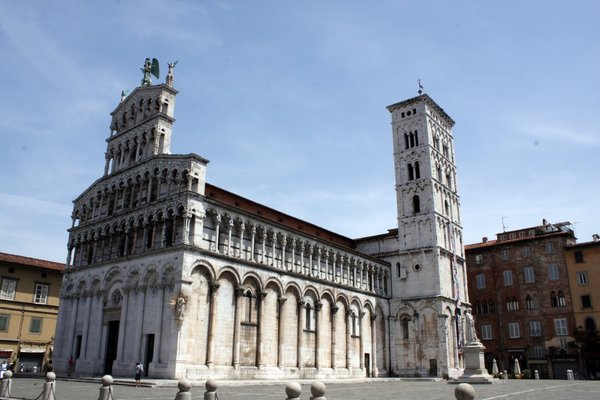
Duomo San Martino, Lucca / Photo by Anya Prosvetova
If you are looking for a lazy day out of Florence with good local food, look no further. Lucca is a city close to the sea, just an hour and ten minutes train ride from Florence. Its historical centre is surrounded by well-preserved Renaissance-era city walls, making the centre entirely pedestrian. Rent a bike or walk atop of the walls for nice views over the city. Another good viewpoint is from the Palazzo Guinigi’s tower, topped by growing trees.
Art enthusiasts should visit the Duomo San Martino in Piazza Antelminelli to appreciate its arched Gothic facade, and Tintoretto’s Last Supper (1590) inside the cathedral, or Lucca Centre of Contemporary Art (Via della Fratta, 36). For something Baroque, visit Palazzo Pfanner and its splendid gardens. In the afternoon enjoy your lunch or yet another espresso in Piazza dell’Anfiteatro. Once an ancient Roman amphitheatre, this large circular square today is the place of a market, not gladiators battles.
Chianti
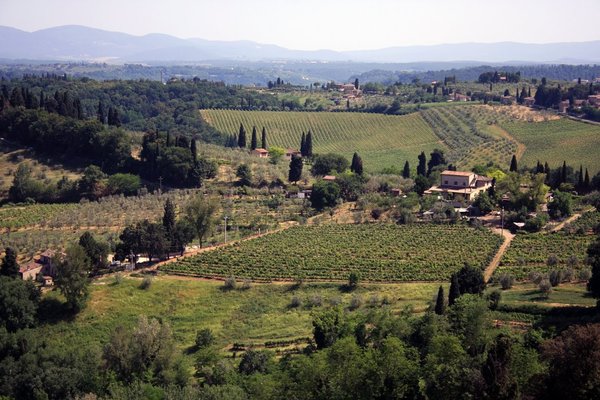
Tuscan countryside / Photo by Anya Prosvetova
Florence is located in one of the most beautiful regions of Italy, Chianti, which is also famous for its red wines. Rent a car for a day to explore the area’s valleys, vineyards, and olive groves. You can also spend several days driving along Chiantigiana Road (SR222) from one village to another, tasting the local fine and food, and staying at a farmhouse or villa. Greve-in-Chianti may be one of the best places to visit, half-hour away from Florence. Located in the heart of the wine region, it has a historic monastery, and hosts an annual wine festival in September.
Useful links
Official website for tourists in Florence
This website provides all essential details about public transport, areas of Florence, places to see, events and exhibitions as well as some useful info on organising your wedding there. Here you can also find useful maps and brochures to help you plan the trip.
There are several tourist offices where you can ask questions and pick up a map, including one in Vespucci Airport of Florence (arrivals side), the railway station (Piazza Stazione 4), and on Piazza del Duomo.
Events and news in Florence
Plan your trip to Florence around temporary exhibitions, concerts, and other events in the city. Firenze Turismo, Visit Florence, The Florentine, and the official website of the city of Florence have comprehensive and up-to-date listings.
Useful Phone Numbers
112 – Police 115 - Fire department 118 - Medical emergency 055-328-333 - Urban Police Emergency 055-328-3942 / 328-3943 - Lost property on bus or tram (via Circondaria 17b)
Medical Help
There is a special Tourist Medical Service, located on Via Lorenzo il Magnifico 59, north of the city center, between the Fortezza del Basso and Piazza della Libertà. It is open 24 hours and can be reached at 055-475-411.
Some of the major hospitals in Florence:
Policlinico di Careggi Viale Morgagni 85: phone 055-42.77.111
**Ospedale S. Maria Nuova ** Piazza S. Maria Nuova 1: phone 055-27581
Centro Traumatologico Ortopedico (CTO) Largo Palagi 1: phone 055-42.78.227
Istituto Ortopedico Toscano (IOT) Viale Michelangelo 41: phone 055-65771
Ospedale Pediatrico Meyer/ Children’s Hospital c/o Villa Ognissanti Viale Pieraccini 24 - Careggi : phone 055 56621
There are several pharmacies in Florence which are open 24 hours:
Farmacia Comunale, Santa Maria Novella inside the Railway Station: phone 055-289.435 or 055-216.761
Molteni Via Calzaiuoli 7: phone 055-289.490
All’Insegna del Moro Piazza S. Giovanni (Duomo) 20: phone. 055-211343 You can find information about all pharmacies in Florence dialling a free number: 800-420-707.
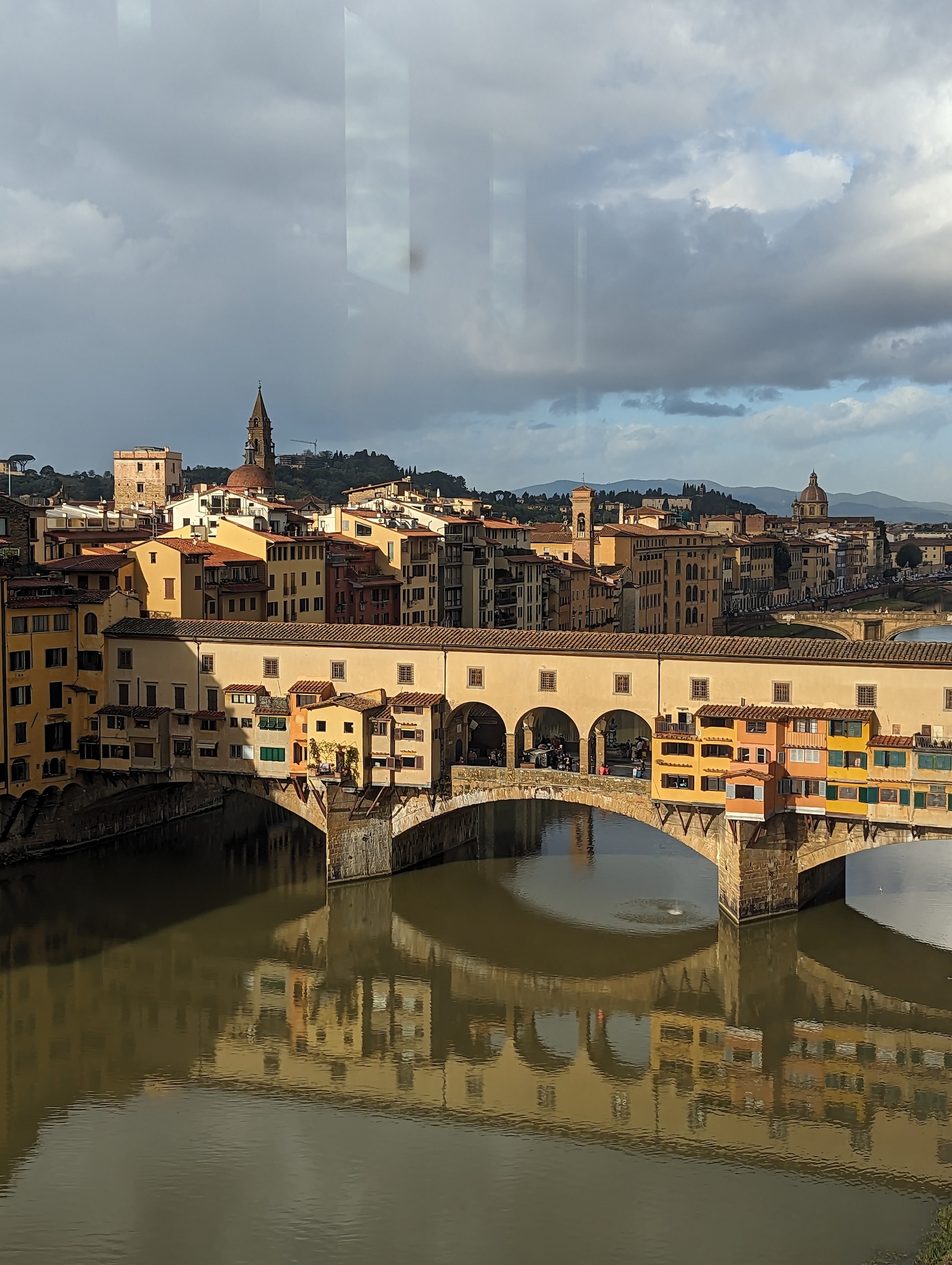
View from the Uffizi Gallery / Photo by Anya Prosvetova
This article was originally published on Routes.Tips.